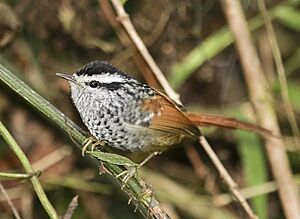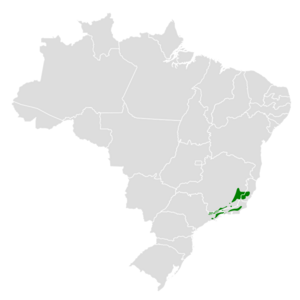Rufous-tailed antbird facts for kids
Quick facts for kids Rufous-tailed antbird |
|
|---|---|
 |
|
| Conservation status | |
| Scientific classification | |
| Genus: |
Drymophila
|
| Species: |
genei
|
 |
|
The rufous-tailed antbird (Drymophila genei) is a small bird. It is found only in Brazil. This bird belongs to a group called "typical antbirds."
Contents
About the Rufous-tailed Antbird
Family Tree
The rufous-tailed antbird is closely related to the ochre-rumped antbird. These two birds are like "sister species." This means they share a recent common ancestor. Each of these species is unique and does not have different types or subspecies.
What It Looks Like
The rufous-tailed antbird is about 13 to 14 centimeters (5 to 5.5 inches) long.
Male birds have a black top of the head. They have a white stripe above their eye. A black stripe goes through their eye. Their cheeks are white with small black spots. Their back is olive-brown with black spots. They have a white patch between their shoulders. Their lower back and tail are a reddish-brown color, called rufous. Their flight feathers are rufous. Their wing feathers are black with white tips. Their throat and chest are white with black spots. The spots are bigger on their chest. Their sides and under their tail are plain rufous-brown.
Female birds look a bit different. They have a rufous-brown top of the head and back of the neck. These parts have dark streaks. They have a whitish stripe above their eye. A dark brown line goes through their eye. Their cheeks are a light yellowish-brown color. Their upper body, wings, and tail are like the male's. But they do not have black spots or the white patch on their back. Their throat and underparts are light yellowish-brown. They might have some faint dark marks on their throat and chest.
Where It Lives and Its Home
Location
The rufous-tailed antbird lives in southeastern Brazil. It is found in parts of Minas Gerais, Espírito Santo, São Paulo, and Rio de Janeiro. Its home areas are not all connected.
Habitat
This bird mostly lives in bamboo patches. These bamboo areas are found in mountain evergreen forests. It also lives in nearby areas with lots of vines. It likes other thick plants too.
You can usually find it between 1,150 and 2,200 meters (3,770 and 7,200 feet) high. Sometimes, it lives as low as 800 meters (2,600 feet).
How It Behaves
Movement
The rufous-tailed antbird is thought to live in the same area all year. It might move to new places if its bamboo home dies off.
Feeding Habits
The rufous-tailed antbird eats mostly arthropods. These are small creatures like insects and spiders. It usually looks for food alone or in pairs. Sometimes, a family group will search together.
They typically forage within 3 meters (10 feet) of the ground. They rarely go as high as 7 meters (23 feet). They sometimes join other bird groups that are feeding. These are called "mixed-species feeding flocks." They rarely follow swarms of army ants. They find their prey by picking it off leaves, vines, and stems. They reach and lunge from a branch to catch their food.
Reproduction and Life Cycle
Scientists do not know much about how the rufous-tailed antbird breeds.
Vocalization
The song of the rufous-tailed antbird is a series of 6 to 7 notes. It starts with a very high "sih." Then it drops to lower, nasal "theeh" notes. It sounds like "síhtjeè-tjeèh-tjeèh."
Its calls include short, flat, thin, and high-pitched notes. These notes come in groups of 3 to 6. It also makes similar groups of longer, raspy "chirrs."
Conservation Status
The IUCN (International Union for Conservation of Nature) checks on animals. They first said the rufous-tailed antbird was "Near Threatened" in 1988. Then it was "Unknown" in 1994. In 2004, it was "Near Threatened" again. Since 2013, it has been listed as "Least Concern." This means it is not in immediate danger of disappearing.
Even though its overall range is big, it lives in separate areas. There are an estimated 6,000 to 58,000 adult birds. This number is thought to be going down. Its home is being changed into land for farms and ranches. Fires also threaten its habitat. It is common in protected areas. However, it has a small range and needs special places to live.


